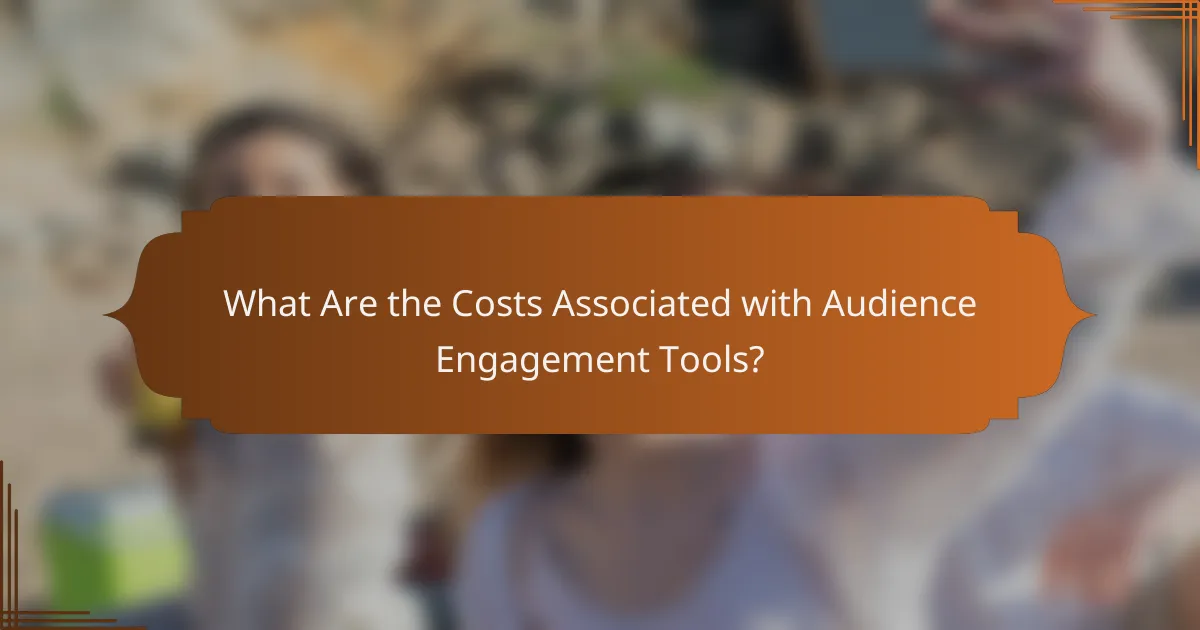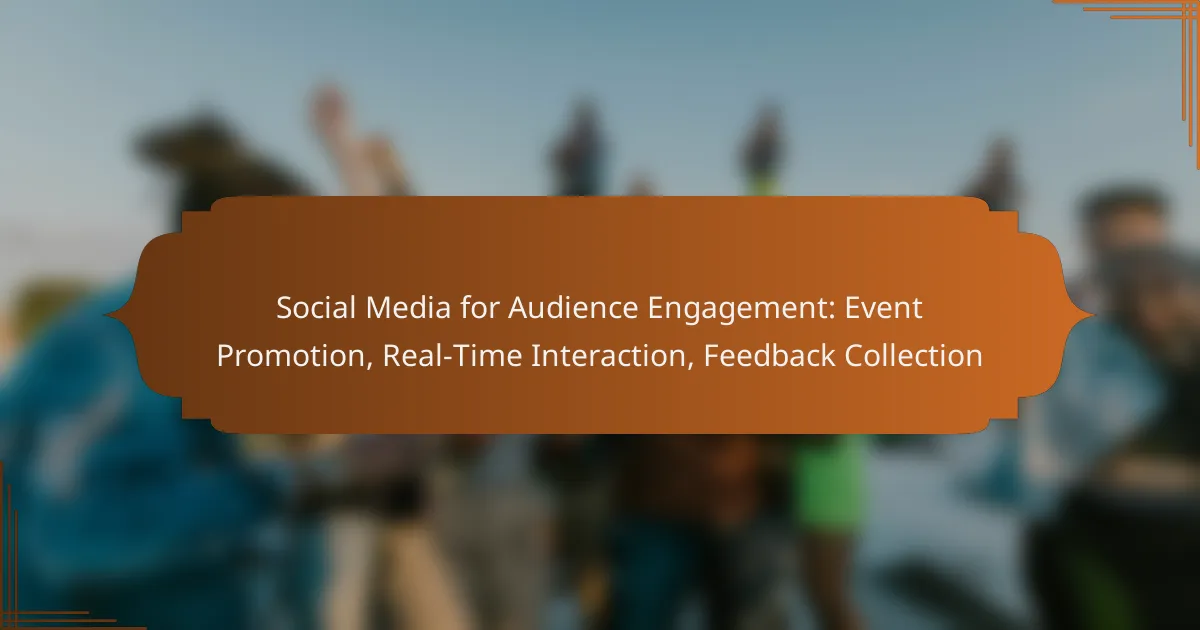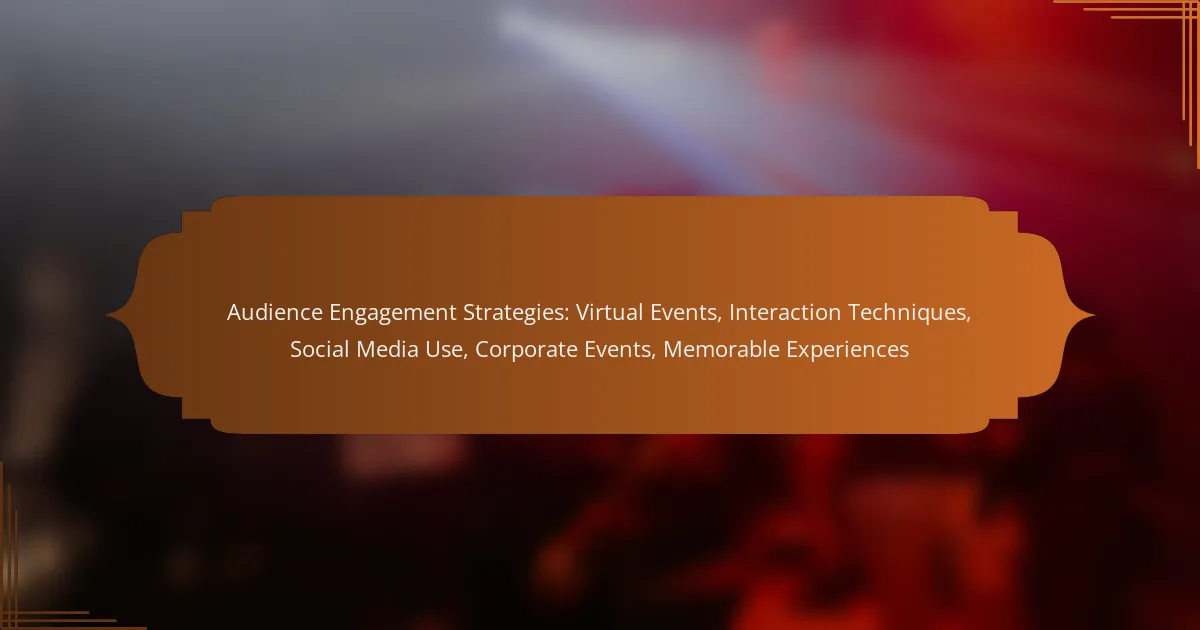Interactive tools for audience engagement at festivals play a crucial role in enhancing participation and creating memorable experiences. By leveraging technology solutions, organizers can facilitate real-time interaction, streamline ticketing, and promote networking, ultimately making events more enjoyable and tailored to individual preferences.

What Are the Best Interactive Tools for Audience Engagement at Festivals?
The best interactive tools for audience engagement at festivals enhance participation, foster communication, and create memorable experiences. These tools can streamline ticketing, facilitate real-time interaction, and promote networking among attendees.
Eventbrite for ticketing and registration
Eventbrite is a leading platform for managing ticketing and registration at festivals. It allows organizers to create customizable event pages, set ticket prices, and track sales easily. With features like mobile ticketing and attendee check-in, it simplifies the entry process for both organizers and attendees.
Consider using Eventbrite if you expect a large audience, as it can handle high volumes of registrations efficiently. Additionally, its integration with various payment processors makes it convenient for users across different regions, including those in the US and Europe.
Slido for live Q&A and polls
Slido is an interactive tool designed for live Q&A sessions and audience polling. It allows attendees to submit questions and vote on them in real-time, ensuring that the most relevant topics are addressed during discussions. This engagement can significantly enhance the overall festival experience.
To maximize its effectiveness, promote Slido before and during the event to encourage participation. You can integrate it with popular presentation software, making it easy to display questions and poll results live on screen.
Whova for attendee networking
Whova is an event management app that focuses on enhancing attendee networking. It provides features like personalized agendas, attendee profiles, and messaging capabilities, enabling participants to connect based on shared interests. This fosters a sense of community and encourages meaningful interactions.
Utilizing Whova can be particularly beneficial for festivals with multiple sessions or workshops, as it helps attendees navigate the event and find relevant connections. Encourage participants to complete their profiles to facilitate better networking opportunities.
Facebook Live for real-time engagement
Facebook Live is a powerful tool for real-time engagement during festivals. It allows organizers to broadcast live events, share behind-the-scenes content, and interact with audiences who cannot attend in person. This can significantly expand your reach and enhance audience involvement.
To effectively use Facebook Live, promote the live sessions in advance and encourage viewers to comment and ask questions during the broadcast. This interaction can create a dynamic atmosphere and keep online audiences engaged.
Instagram Stories for interactive content
Instagram Stories are an excellent way to share interactive content during festivals. They allow organizers to post polls, quizzes, and questions, encouraging audience participation and feedback. This feature can keep attendees engaged and informed about festival happenings in a fun way.
To leverage Instagram Stories effectively, use eye-catching visuals and consistent branding. Regularly update your stories throughout the festival to maintain excitement and encourage attendees to share their experiences, further amplifying your event’s reach.

How Can Technology Solutions Enhance Audience Participation?
Technology solutions can significantly enhance audience participation by creating more engaging and interactive experiences. These tools allow organizers to tailor events to individual preferences, making participation more meaningful and enjoyable.
Mobile apps for personalized experiences
Mobile apps can provide personalized experiences by offering features like customized schedules, notifications, and interactive maps. Attendees can receive real-time updates about activities, allowing them to plan their day according to their interests.
When developing a mobile app, consider incorporating user profiles where attendees can select their preferences. This can help in sending targeted messages and recommendations, enhancing their overall experience at the festival.
Augmented reality for immersive interactions
Augmented reality (AR) can create immersive interactions that captivate audiences by blending digital content with the real world. For example, attendees can use AR to access interactive exhibits or games that enhance their understanding of the festival’s theme.
To implement AR effectively, ensure that the technology is user-friendly and accessible. Providing clear instructions and support can help participants engage fully with the AR experiences, leading to higher satisfaction levels.
Live streaming for remote participation
Live streaming allows remote participants to engage with events in real-time, expanding the audience beyond those physically present. This technology is particularly beneficial for festivals, as it enables people from different locations to join in on the experience.
When planning live streaming, invest in high-quality equipment and a reliable internet connection to minimize disruptions. Consider offering interactive features, such as live chats or Q&A sessions, to make remote viewers feel included.
Social media integration for broader reach
Integrating social media into events can significantly broaden reach and enhance audience engagement. By encouraging attendees to share their experiences online, festivals can create a sense of community and attract more participants.
To maximize social media impact, create unique hashtags and encourage attendees to post photos and updates. Additionally, consider running contests or giveaways that incentivize social sharing, further amplifying the festival’s visibility.

What Are the Key Features of Effective Engagement Tools?
Effective engagement tools are designed to enhance audience interaction through intuitive design, real-time data, and flexibility. Key features include user-friendly interfaces, real-time analytics, customization options, and multi-platform compatibility, all of which contribute to a more engaging experience for festival attendees.
User-friendly interfaces
User-friendly interfaces are crucial for ensuring that all participants can easily navigate engagement tools. A clean layout, intuitive navigation, and clear calls to action help minimize confusion and enhance user experience. Tools should prioritize accessibility, allowing users of varying tech-savviness to engage without frustration.
Consider implementing features like drag-and-drop functionality or guided tours to help users familiarize themselves with the tool quickly. Avoid cluttered designs that can overwhelm users and detract from the primary engagement goals.
Real-time analytics and feedback
Real-time analytics and feedback allow event organizers to monitor engagement levels and participant interactions as they happen. This feature enables quick adjustments to strategies, ensuring that the audience remains engaged throughout the event. Metrics such as participation rates, user interactions, and feedback scores can provide valuable insights.
Utilize dashboards that display key performance indicators (KPIs) in an easily digestible format. Regularly reviewing this data can help identify trends and areas for improvement, enhancing future events and engagement strategies.
Customization options for branding
Customization options for branding are essential for aligning engagement tools with the festival’s identity. This includes the ability to modify colors, logos, and messaging to create a cohesive experience that resonates with attendees. Strong branding can enhance recognition and foster a sense of community among participants.
Consider offering templates that allow for easy customization while maintaining a professional appearance. Avoid overly complex customization processes that could deter users from personalizing their experience.
Multi-platform compatibility
Multi-platform compatibility ensures that engagement tools function seamlessly across various devices, including smartphones, tablets, and desktops. This flexibility allows participants to engage with the festival from their preferred device, increasing overall participation rates. Tools should be optimized for both iOS and Android systems, as well as different web browsers.
Test the tools on multiple platforms before the event to identify any potential issues. Prioritize responsive design to ensure that content adapts well to different screen sizes, providing a consistent experience for all users.

What Are the Costs Associated with Audience Engagement Tools?
The costs associated with audience engagement tools can vary significantly based on the type of tool and its features. Understanding these costs is essential for budgeting effectively for festivals and events.
Subscription models for software
Many audience engagement tools operate on a subscription model, which typically involves monthly or annual fees. These fees can range from low tens of USD for basic plans to several hundred USD for advanced features and larger audiences.
When choosing a subscription, consider the number of users, the level of customer support, and any additional features included. It’s often beneficial to start with a trial period to assess the tool’s effectiveness before committing to a longer-term subscription.
One-time fees for event platforms
Some event platforms charge a one-time fee for access to their services, which can be advantageous for festivals with a fixed budget. These fees can vary widely, often falling between a few hundred to several thousand USD, depending on the platform’s capabilities and the scale of the event.
Evaluate what features are included in the one-time fee, such as ticketing, analytics, and attendee engagement tools. This can help you determine if the upfront cost is justified compared to ongoing subscription fees.
Additional costs for premium features
Many audience engagement tools offer premium features that come with additional costs. These can include advanced analytics, custom branding, or enhanced support options, which may add anywhere from a few dozen to several hundred USD to your overall budget.
Before opting for premium features, assess whether they align with your event goals and if the benefits outweigh the costs. It’s often wise to prioritize features that directly enhance audience interaction and engagement.

How Do You Choose the Right Tool for Your Festival?
Choosing the right tool for your festival involves understanding your audience’s needs and ensuring the technology integrates seamlessly with your existing systems. Prioritize tools that enhance engagement and streamline participation while fitting your budget and technical capabilities.
Assess audience demographics
Understanding your audience demographics is crucial for selecting the right engagement tool. Consider factors such as age, interests, and technological proficiency, as these will influence how attendees interact with your festival. For example, younger audiences may prefer mobile apps, while older attendees might appreciate simpler, web-based solutions.
Gather data through surveys or social media analytics to identify trends and preferences. This information can guide you in choosing features that resonate with your audience, such as live polling, interactive maps, or social media integration.
Evaluate integration capabilities
Integration capabilities are essential for ensuring that your chosen tool works well with existing systems, such as ticketing platforms and marketing software. Look for tools that offer APIs or built-in integrations to facilitate data sharing and enhance user experience. This can save time and reduce errors during the event.
Consider the technical support provided by the tool’s vendor. A responsive support team can help troubleshoot issues and ensure smooth operation during the festival. Additionally, assess whether the tool can scale with your festival’s growth, accommodating more attendees or features as needed.



